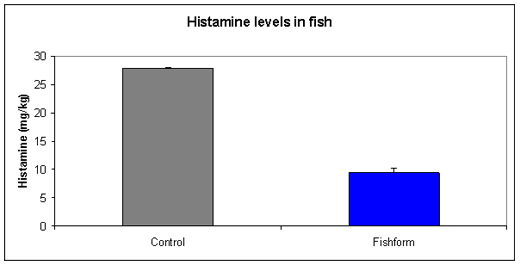fish meal
Fresh fish for high quality fish meal
Storage time (h) | 24 | 48 | 72 | |||
KDF | TVN (mg/100g) | DM (%) | TVN (mg/100g) | DM (%) | TVN (mg/100g) | DM (%) |
0.0% | 26.0a | 24.9 | 59.4b | 24.3 | 52.4b | 26.0 |
0.4% | 25.2a | 26.1 | 30.2a | 24.9 | 37.5a | 26.3 |

Figure 1: Good quality Sardines for further fish meal production

Figure 2: Development of histamine levels (average ± SD) after 48 h of storage with or without FISHFORM
Dear Dr. Mashhadi,
your answer refers to a recent study done by Mikkelsen et al. 2009 which showed encouraging results with KDF on controlling mortality in poultry infected with necrotic enteritis.
However this study was done with a crystalline feed additive containing 97[percent] potassium diformate (KDF), while the afore mentioned study refers to a liquid blend containing KDF which is meant to treat fish for further fish meal production.
Therefore there are two different ways of inclusion and two different products - one into the raw material (fish meal only), the other one directly into the feed.
I hope this answer clarifies your comments.
Lückstädt, ADDCON
Dear Amr,
thank you for your comment regarding the article on the use of potassium diformate (KDF) in the preservation of raw fish.
The substance was extensively tested on further effects in fish as well as in human. To start with the human side first - potassium diformate got the EU approval as preservative for raw fish which is meant for fish meal production (EC no. 237a). In order to achieve this approval, several tests had to be carried out - including toxicological studies involving the safety of humans hence the safety of the consumer is given!
On the other hand - you are right with potential effects of animals consuming fish meal treated with potassium diformate KDF. Christiansen & Lückstädt (2008) published a study on the performance enhancement in Salmon fed with fishmeal treated with KDF, which showed improved growth and feed conversion. Furhter studies using KDF as direct feed additive in fish (for instance tilapia) were recently published by Zhou et al 2009 and Ng et al. 2009, both showing beneficial effects on tilapia performance. A review on the use of potassium diformate, as well as other organic acids or their salts was published by Lückstädt in 2008 (The use of acidifiers in fish nutrition). So to make the answer short: there are certainly beneficial effects of acids in fish diets as well as in pig and poultry...
Dear Lückstädt, ADDCON
Thanks a lot for your valuable information about fish meal
The Article: Fresh fish for high quality fish meal ia a valuable information but the duration of critical storage period is an important factor as KDF holds promise as an agent to control necrotic enteritis in broiler chickens and it may be possible to enhance the efficacy of KDF by manipulating dietary properties that may influence the dissociation kinetics of KDF in the gut.

Hi,
i find this article avery good start,but what about the effect of formate on fishmeal
and the fish that will be fed this fish meal
i think fomate has got direct effect on bacteria so can it also affect fish and after that human








.jpg&w=3840&q=75)